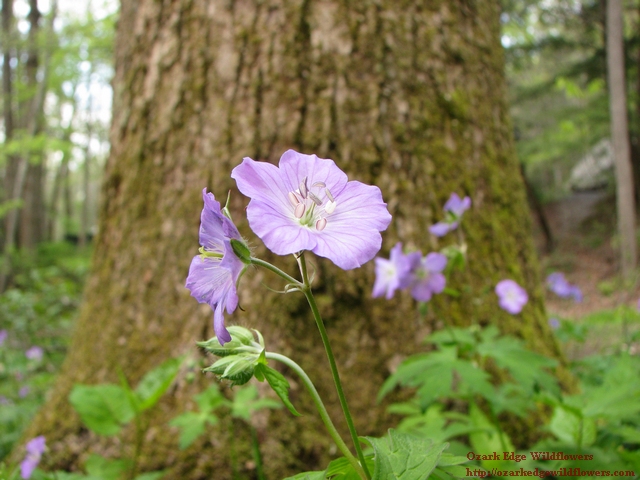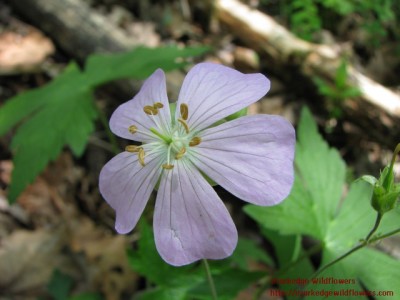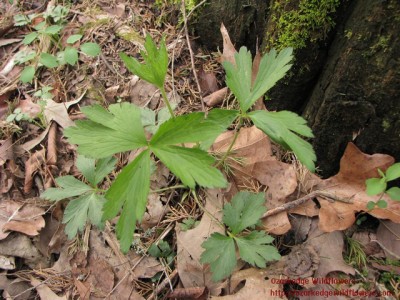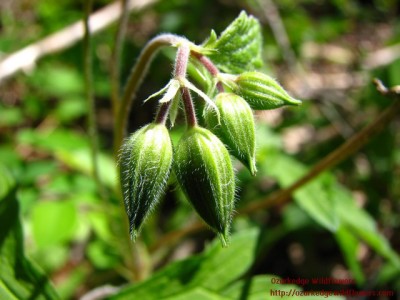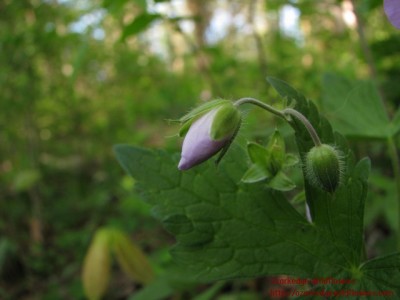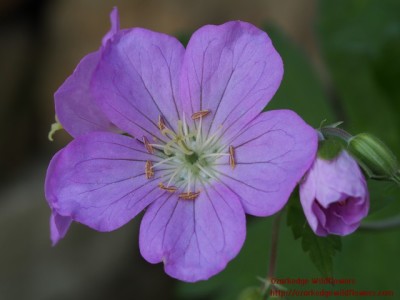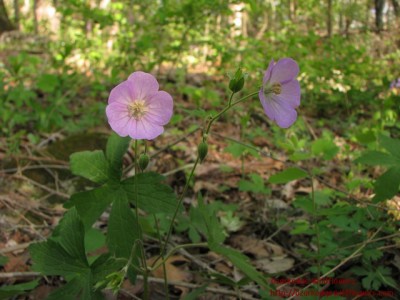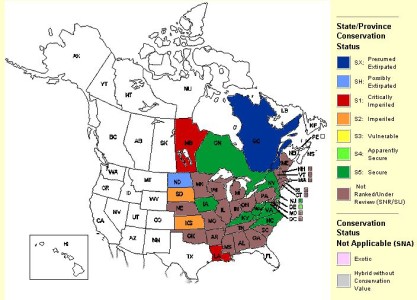I love wild geraniums. The delicate pink flowers sway and dance with any soft breeze , bringing to my mind’s eye the picture of a little girl dancing in a new pink dress.
Latin Name/Common Name- The word Geranium is derived from the Greed word for crane- geranos. This is in reference to the shape of fruit capsule, which has a long beak-like structure. This structure is also the genesis of one of the common names- Crane’s bill.
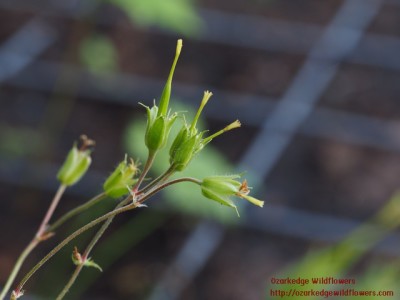 Fruit capsule shaped like a crane’s beak
Fruit capsule shaped like a crane’s beak
The word maculatum means spotted and refers to the brown spots that are sometimes seen on the leaves.
Bloom Color- The color saturation of Geranium maculatum varies with the age of the flower. It begins darker and fades to the soft pink we associate with cotton candy. Occasionally white forms are seen.
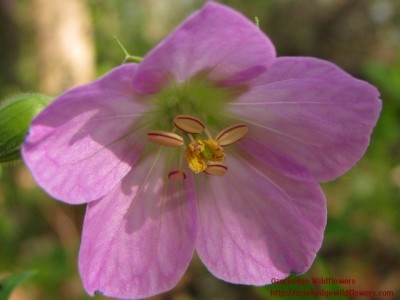
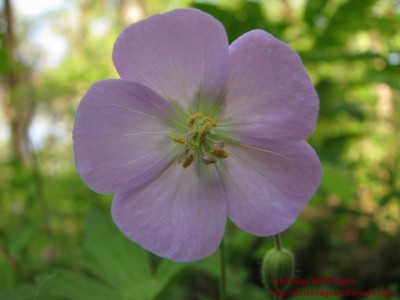 Young flower on left is a darker shade compared to mature flower on right
Young flower on left is a darker shade compared to mature flower on right
Description- This native wild flower has a simple and delightful beauty. The root is a rhizome that spreads to form loose colonies of many individual plants, each producing a multitude of the large, pink flowers. A woodland colony in full bloom is truly a beautiful site.
Mature plants are about 1.5 foot tall. The large, complex leaves are about 5 inches across. They have a palmate shape that is unique in the spring woods and quite attractive. Each leaf is deeply lobed into 5 lobes with sublobes and teeth at leaf tips. The stem, leaves, petioles and buds are all hirsute.
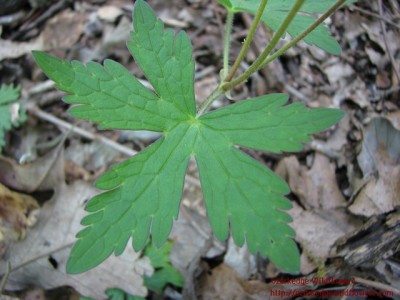 Leaves have 5 main lobes, multiple secondary lobes and coarse teeth
Leaves have 5 main lobes, multiple secondary lobes and coarse teeth
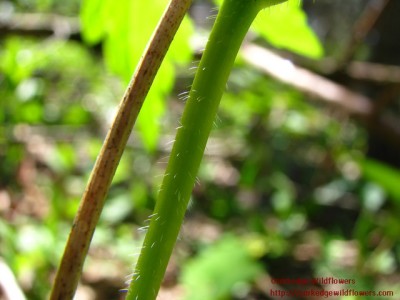 Coarsely hairy stem (green stem)
Coarsely hairy stem (green stem)
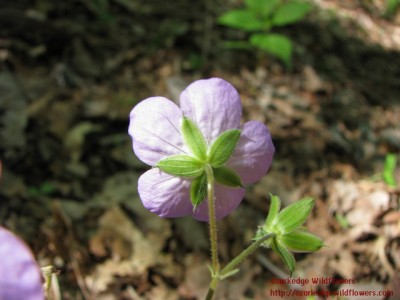 Each flower has 5 petals and 5 green sepals
Each flower has 5 petals and 5 green sepals
The dark lines seen on each flower act as nectar guides which direct the insects to the nectaries.
Geranium maculatum has an interesting way to avoid self pollination. There are 10 stamens placed in a circle around the style. The outer half of the stamens develop within 1 or 2 days of the flower opening. The inner half of the stamens delay their maturation until day 2 or 3. The stigma waits development until the stamens have mostly shed their pollen, at which point the naked anthers are completely dropped from the filaments. This sequence of development prevents the male (stamens) and female (stigma) being fertile simultaneously on an individual flower- thus avoiding self pollination and preserving gene diversity.
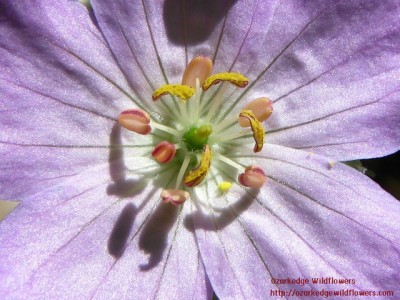 Picture showing inner stamens are covered in pollen
Picture showing inner stamens are covered in pollen
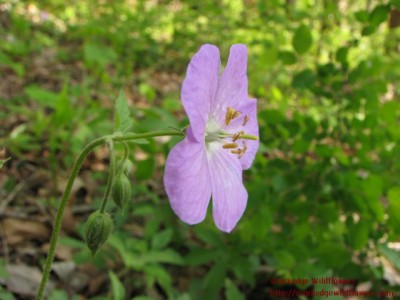 Style has not opened yet in this young flower
Style has not opened yet in this young flower
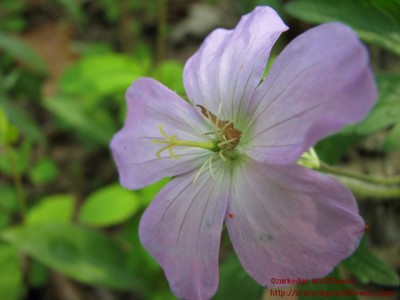 After anthers have dropped off (dehisced) the style has opened to reveal 5 stigma ready for pollination
After anthers have dropped off (dehisced) the style has opened to reveal 5 stigma ready for pollination
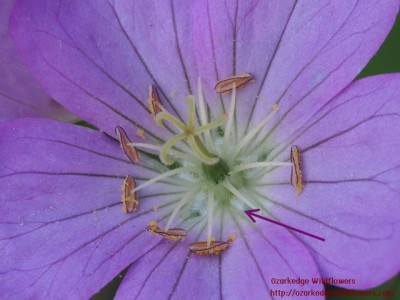 A close look reveals the soft white hairs protecting the nectaries (arrow)
A close look reveals the soft white hairs protecting the nectaries (arrow)
Bloom Time- In the succession of spring wildflowers, Wild geranium waits to bloom until after the flowers of Bloodroots and Dutchman’s Breeches have faded. She prefers to bloom in the more dependably warmer weather of mid April to mid May. Warmer springs may bring a few flowers in early April.
Below is a series of pictures showing Geranium maculatum from early spring foliage, formation of buds, mature flowers and the beginning of seed development.
Habitat- Geranium maculatum is an understory plant in submesic communities. Submesic means that the soil is drained from moisture a bit more quickly than a Mesic site (well-balanced supply of moisture). Typical hardwood trees found on the site are Red Oak, White Oak and Hickory.
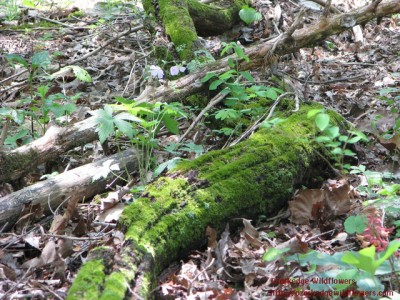 Wild geranium (before bloom) adjacent to mossy log in rich woodland
Wild geranium (before bloom) adjacent to mossy log in rich woodland
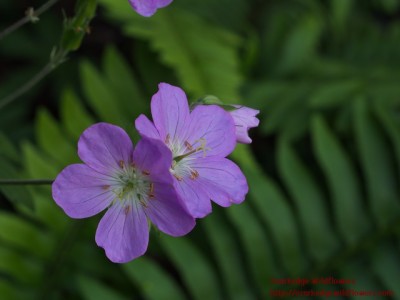 Wild geranium and native Christmas fern (Polystichum acrostichoides)
Wild geranium and native Christmas fern (Polystichum acrostichoides)
What’s Growing Nearby? On Ozarkedge Geranium maculatum is found growing near late blooming spring wildflowers such as Polygonatum pubescens (Solomon’s seal), Maianthemum racemosa (False Solomon’s seal), Trillium recurvatum (Prairie trillium), Podophyllum peltatus (Mayapple), Thalictrum thalictroides (Rue Anemome), Phlox divariata (Woodland phlox) and Uvularia grandiflora (Large flowered bellwort).
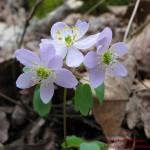
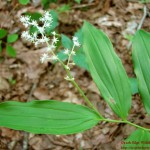
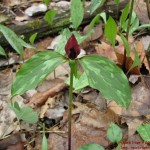 Thalictrum thalictroides Maianthemum racemosum Trillium recurvatum
Thalictrum thalictroides Maianthemum racemosum Trillium recurvatum
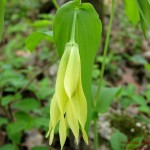
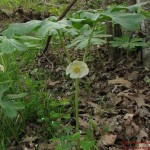
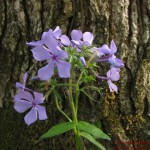 Uvularia grandiflora Podophyllum peltatum Phlox divaricata
Uvularia grandiflora Podophyllum peltatum Phlox divaricata
Geranium maculatum is losing ground in North America. Natureserve shows it is Presumed extirpated in Quebec, Possibly extirpated in North Dakota, Critially imperiled in Manitoba and Lousiana, and Imperiled in South Dakota and Kansas. Within most of its native range in the United States it’s status is Not Ranked. Unfortunately, this includes Arkansas. Here’s the link to the Natureserve site.
*NatureServe. 2018. NatureServe Explorer: An online encyclopedia of life [web application]. Version 7.1. NatureServe, Arlington, Virginia. Available http://explorer.natureserve.org. (Accessed: March 9, 2019 ).
Interesting Tidbits- Plants employ many different methods to disperse their seeds. Geranium maculatum has one of the best. As the seeds inside the capsule become ripe, the dried covering (made of 5 parts) curls backwards in a sudden act that catapults the seeds away from the mother plant. Each seed has a small appendage that assumes a curved shape when moist and straight when dry. This curving and straightening helps the seed creep along its way and eventually achieve its final destination in the soil where it can germinate in the spring.
